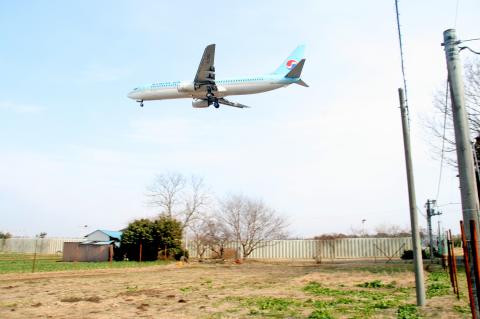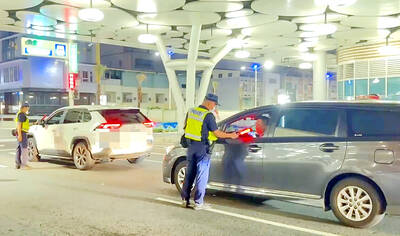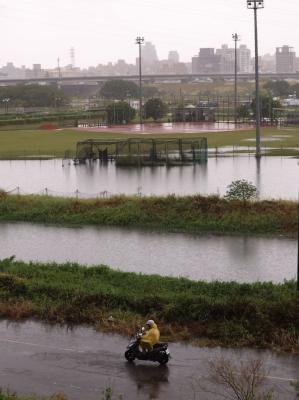While many families affected by the Taoyuan Aerotropolis project are fiercely resisting forced land seizures by the government, a group of people in Japan has been resisting expropriations for nearly 50 years and has blocked Narita International Airport — the largest airport in Japan — from being completed as initially planned.
With more than 200,000 flights landing and taking off, carrying more than 30 million passengers a year, Narita International Airport in Chiba Prefecture not far from Tokyo may seem to be just like any other busy airport at first sight, but travelers may notice something unusual, such as a large sign that says “down with Narita Airport” in both English and Japanese, as well as steel towers, some with protest banners hanging from them, right outside the airport fence.
“The airport is technically unfinished, though it has been in operation for decades,” said Eiichi Koyama, editor-in-chief of Weekly Sanrizuka and a member of the Farmers’ League Against Narita Airport, standing on one of the observation towers built by activists against land expropriation for Narita airport, right outside the airport fence. “The land expropriation is not done yet.”

Photo: Loa Iok-sin, Taipei Times
According to the original construction plan, which was revealed in 1966, Narita International Airport was supposed to have two 4km runways, one 3.6km runway and two 2.5km runways, but only the 4km runway A had been completed when the airport was opened in 1978, which was a seven-year delay as the airport was originally scheduled to be inaugurated in 1971.
It was not until 2002 that the 2.2km runway B — which was also supposed to be 4km long — was completed. It was later expanded to 2.5km in 2009, but the construction of the rest of the runways has been postponed indefinitely.
Within and outside the airport premises, there are still two private homes, an agricultural product manufacturing plant, a Shinto shrine and farms belonging to local residents who are opposed to forced expropriation for the airport that started nearly half a century ago.
“The resistance to the land seizures began when the government first announced that a new airport would be built in Sanrizuka village in Narita,” 92-year-old Koji Kitahara, who has headed the activist league since the beginning, told the Taipei Times. “The announcement came as a surprise, because we were never consulted in advance and I believe that anyone, anywhere, would rise up against it.”
In fact, it was the village of Tomisato — about 5km away — that was first selected for the airport, but the site was later relocated to Sanrizuka due to strong opposition.
“The Cabinet believed there would be less opposition because more than half of the land in Sanrizuka belongs to the Chiba Prefecture Government and the imperial family,” Kitahara said. “So, before we were consulted or reacted, the decision to move the project to Sanrizuka was finalized.”
He added that it took the government only two weeks between the first announcement and the final decision.
“We put a lot of hope in the Emperor, we petitioned him asking him not to agree to give up Imperial lands, but the emperor let us down,” Kitahara said. “To our disappointment, he quickly agreed to give up imperial estates for airport construction.”
Despite the disappointment, Kitahara and other Sanrizuka villagers — 325 families and more than 1,000 residents — continued to petition officials at the local and central level, but all efforts were in vain.
“We petitioned the Ministry of Land, Infrastructure, Transport and Tourism, but officials told us that they had no choice and asked us to tolerate it for the good of the public,” Kitahara said.
“Since my grandfather’s time, my family has been living here in Sanrizuka as farmers, growing agricultural products organically,” said Toichi Shito, a local farmer. “This is our home, we will not give it up.”
Shito said that in addition to families that have been living in Sanrizuka for centuries, there are many families of former soldiers or overseas Japanese who were settled in Sanrizuka by the government after World War II, and that it took them decades of effort and hard labor to improve the quality of the soil.
“How is it possible for them to just give up the land?” Shito asked.
At first, villagers’ protests were rather peaceful, but they turned violent when the government authorized forcible land expropriation and eviction of residents in 1969. The seizures did not happen until 1971, the year when the airport was supposed to have been completed under the original plan.
“Police and troops moved in, trying to tear down private homes and steel towers built by protesters — including local villagers, and thousands of university students and activists from across the country — leading to violent clashes,” said Koyama, who was among the student activists who joined the resistance movement in the 1970s.
Among a series of conflicts, the most severe occurred in September 1971 when 5,300 police officers clashed with about 5,000 protesters, leading to the arrest of 475 protesters, hundreds of injuries on both sides and the deaths of three officers.
Finally, the airport inauguration was set for 1978, but only one terminal and one runway had been completed at that time — and the inauguration was further postponed, since protesters occupied the control tower on the scheduled day of the inauguration on March 26 amid tightened security measures.
Following the bloodshed in the 1970s, the protests continued, but they were non-violent and still continue today — with the two private homes, a factory, shrine and farms remaining as enclaves within the airport, blocking it from being completed.
“Politicians have continued to try and convince me to give up by offering me government positions or large compensation, but I turned down all the offers,” Kitahara said.
“The government made a mistake. It has to apologize and to fundamentally change the way it makes decisions,” he said.
Koyama agreed, saying that it was a crime by the government and giving up would mean consenting to the government’s wrongdoing.
“This is why I’ve stayed in the movement for almost 40 years,” he said.

TRAFFIC SAFETY RULES: A positive result in a drug test would result in a two-year license suspension for the driver and vehicle, and a fine of up to NT$180,000 The Ministry of Transportation and Communications is to authorize police to conduct roadside saliva tests by the end of the year to deter people from driving while under the influence of narcotics, it said yesterday. The ministry last month unveiled a draft of amended regulations governing traffic safety rules and penalties, which included provisions empowering police to conduct mandatory saliva tests on drivers. While currently rules authorize police to use oral fluid testing kits for signs of drug use, they do not establish penalties for noncompliance or operating procedures for officers to follow, the ministry said. The proposed changes to the regulations require

The Executive Yuan yesterday announced that registration for a one-time universal NT$10,000 cash handout to help people in Taiwan survive US tariffs and inflation would start on Nov. 5, with payouts available as early as Nov. 12. Who is eligible for the handout? Registered Taiwanese nationals are eligible, including those born in Taiwan before April 30 next year with a birth certificate. Non-registered nationals with residence permits, foreign permanent residents and foreign spouses of Taiwanese citizens with residence permits also qualify for the handouts. For people who meet the eligibility requirements, but passed away between yesterday and April 30 next year, surviving family members

Taipei, New Taipei City, Keelung and Taoyuan would issue a decision at 8pm on whether to cancel work and school tomorrow due to forecasted heavy rain, Keelung Mayor Hsieh Kuo-liang (謝國樑) said today. Hsieh told reporters that absent some pressing reason, the four northern cities would announce the decision jointly at 8pm. Keelung is expected to receive between 300mm and 490mm of rain in the period from 2pm today through 2pm tomorrow, Central Weather Administration data showed. Keelung City Government regulations stipulate that school and work can be canceled if rain totals in mountainous or low-elevation areas are forecast to exceed 350mm in

China Airlines Ltd (CAL) yesterday morning joined SkyTeam’s Aviation Challenge for the fourth time, operating a demonstration flight for “net zero carbon emissions” from Taiwan Taoyuan International Airport to Bangkok. The flight used sustainable aviation fuel (SAF) at a ratio of up to 40 percent, the highest proportion CAL has achieved to date, the nation’s largest carrier said. Since April, SAF has become available to Taiwanese international carriers at Taipei International Airport (Songshan airport), Kaohsiung International Airport and Taoyuan airport. In previous challenges, CAL operated “net zero carbon emission flights” to Singapore and Japan. At a ceremony at Taoyuan airport, China Airlines chief sustainability